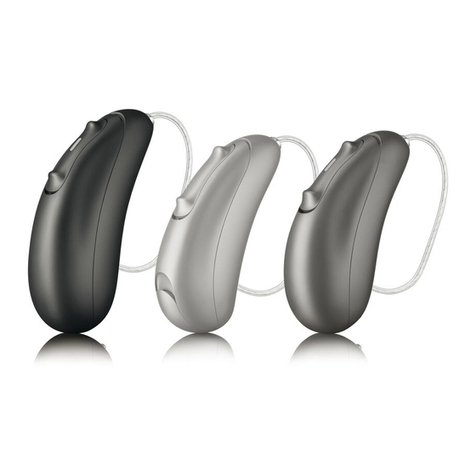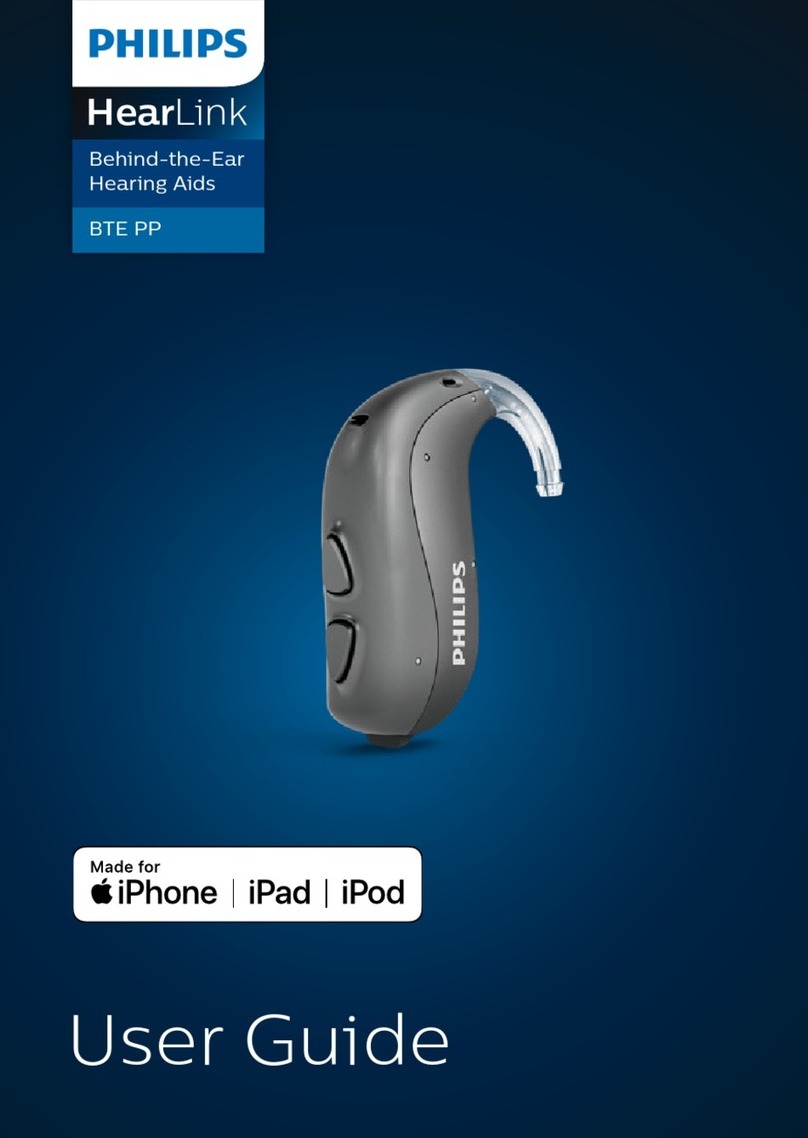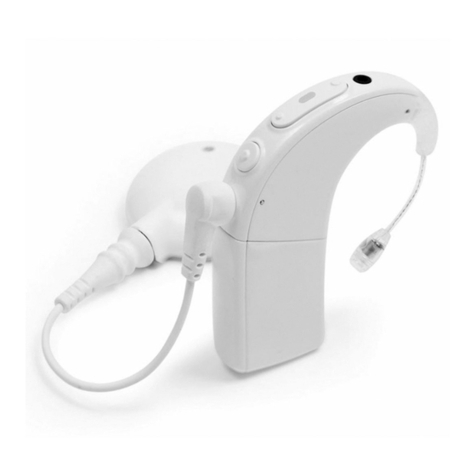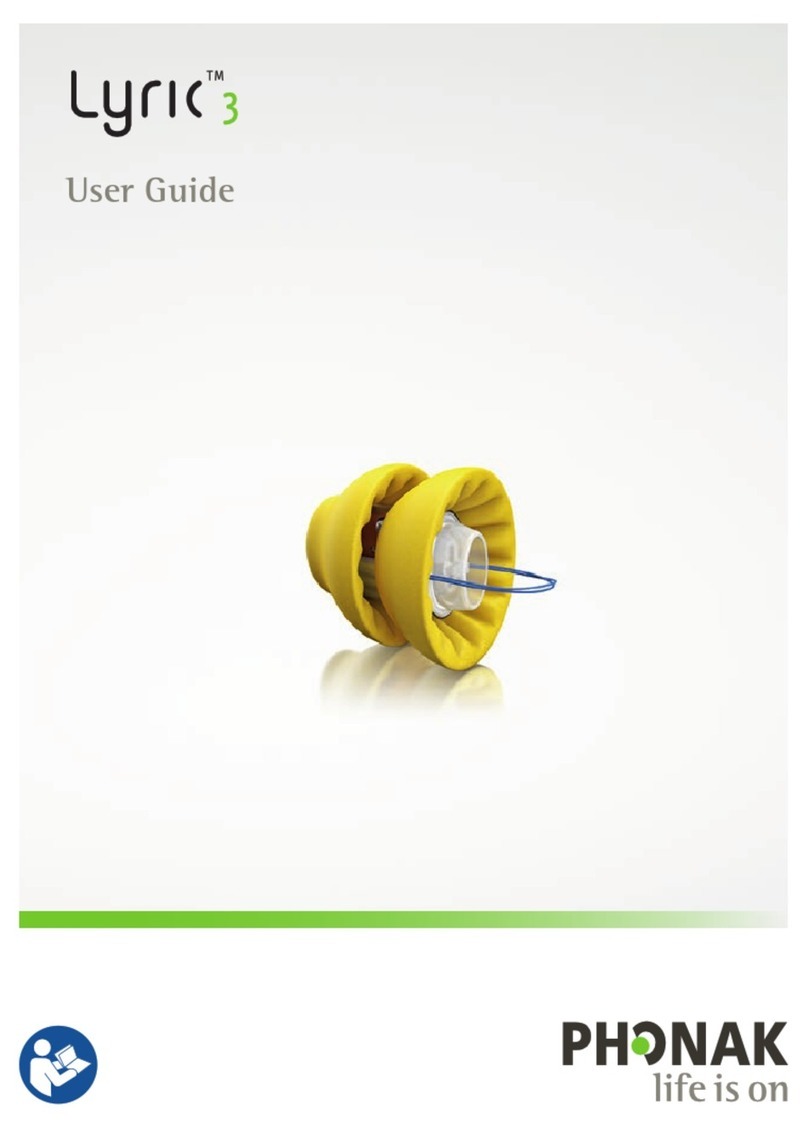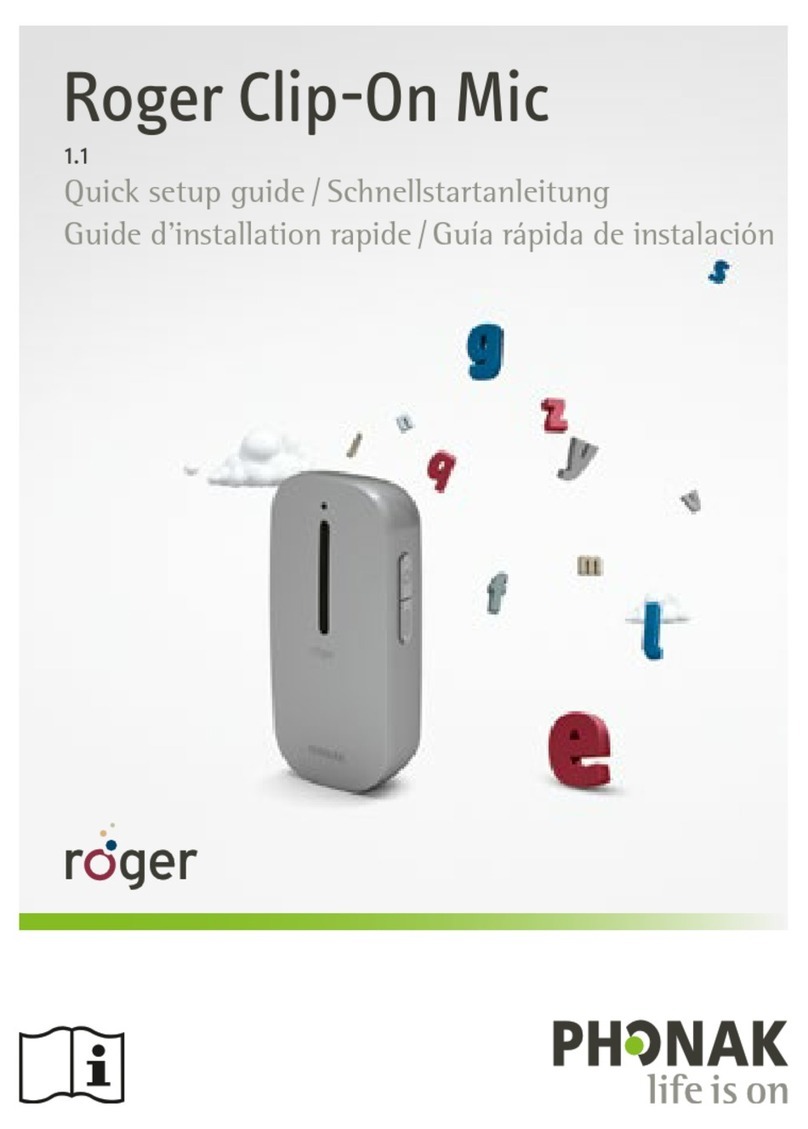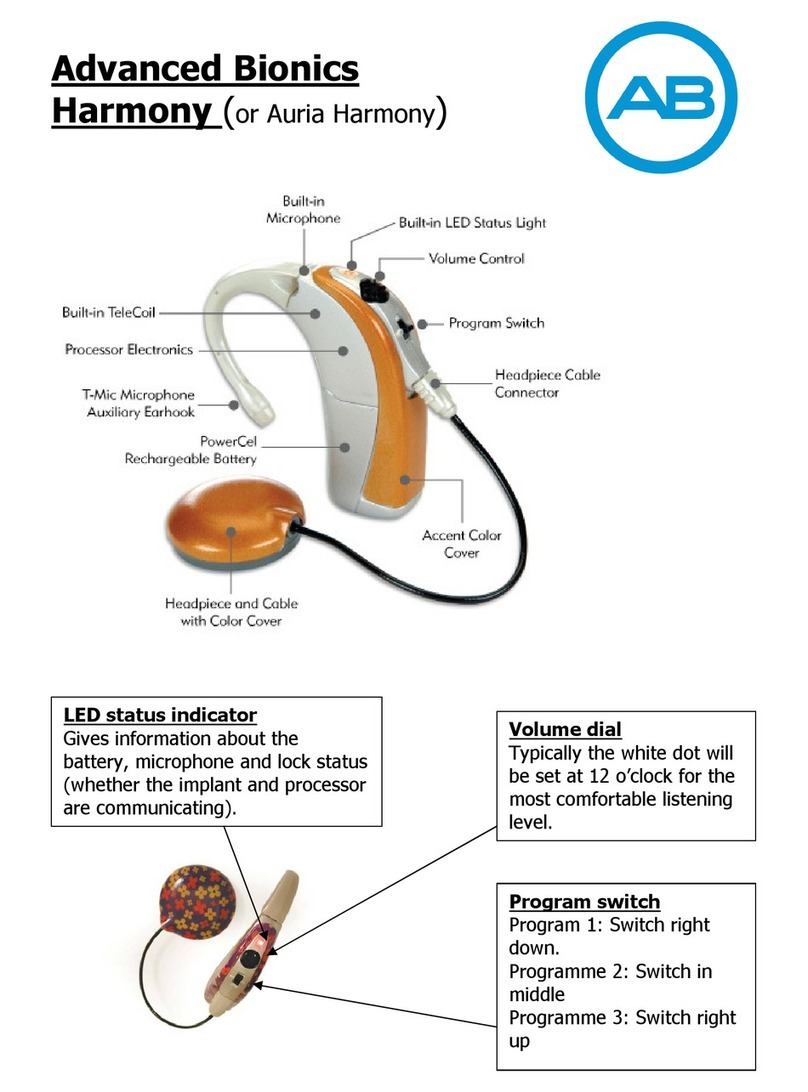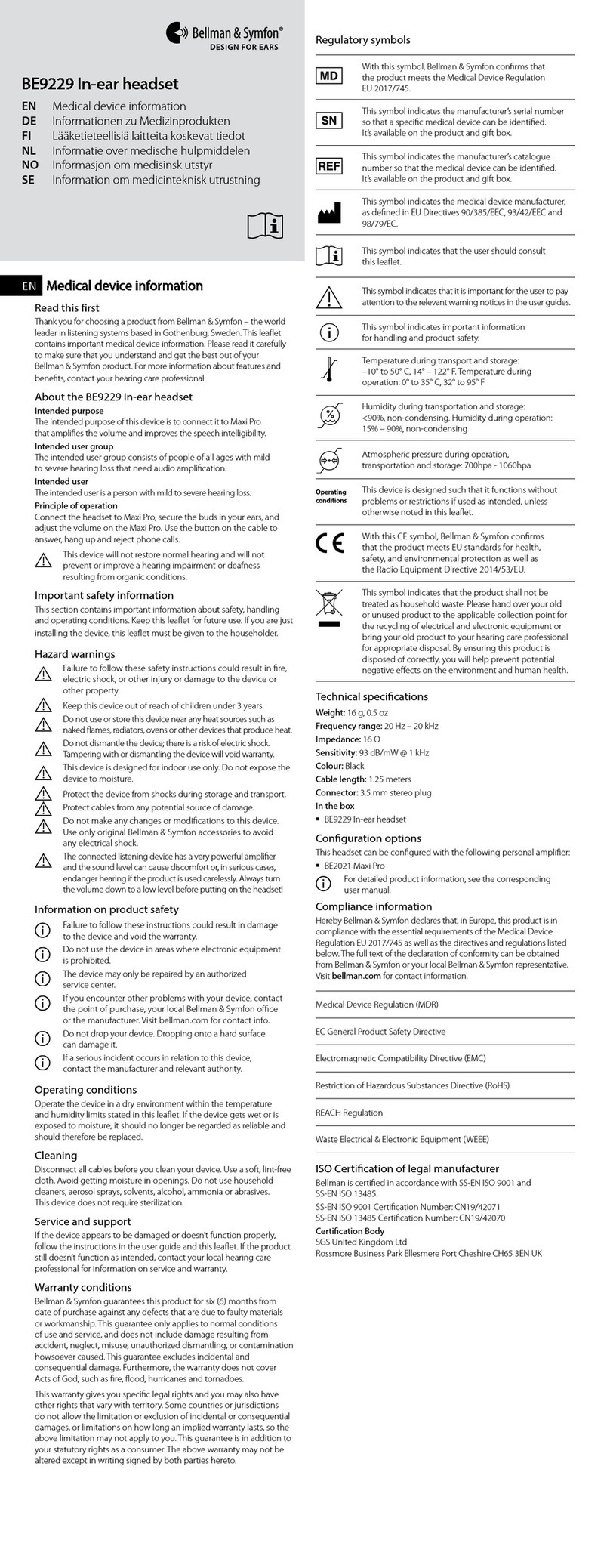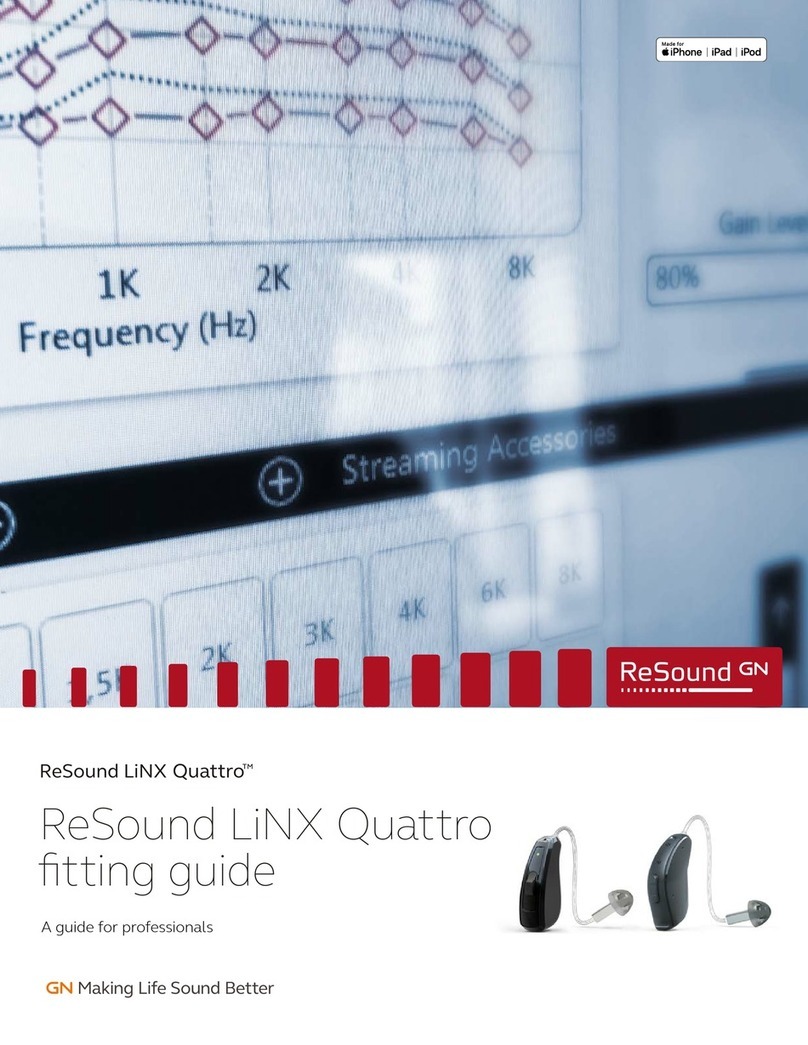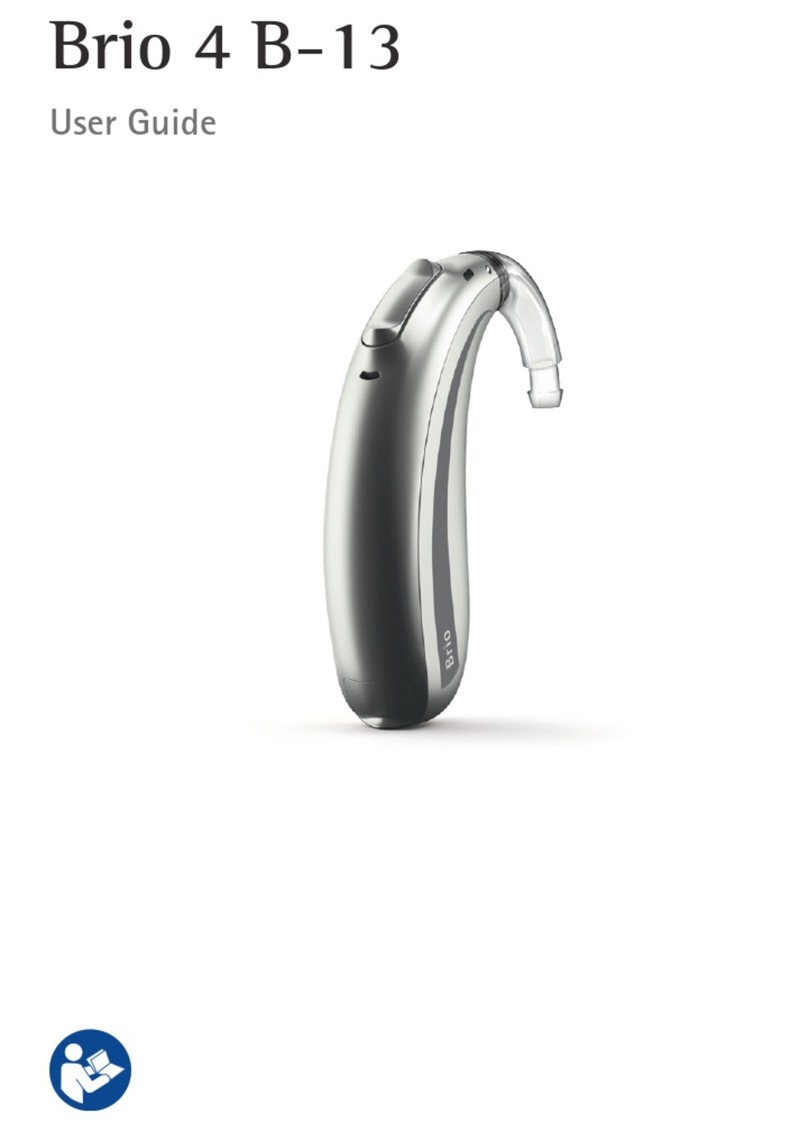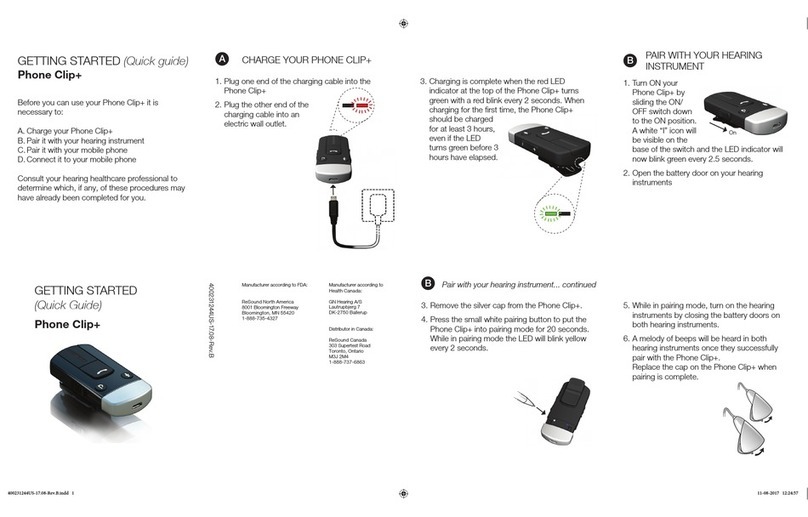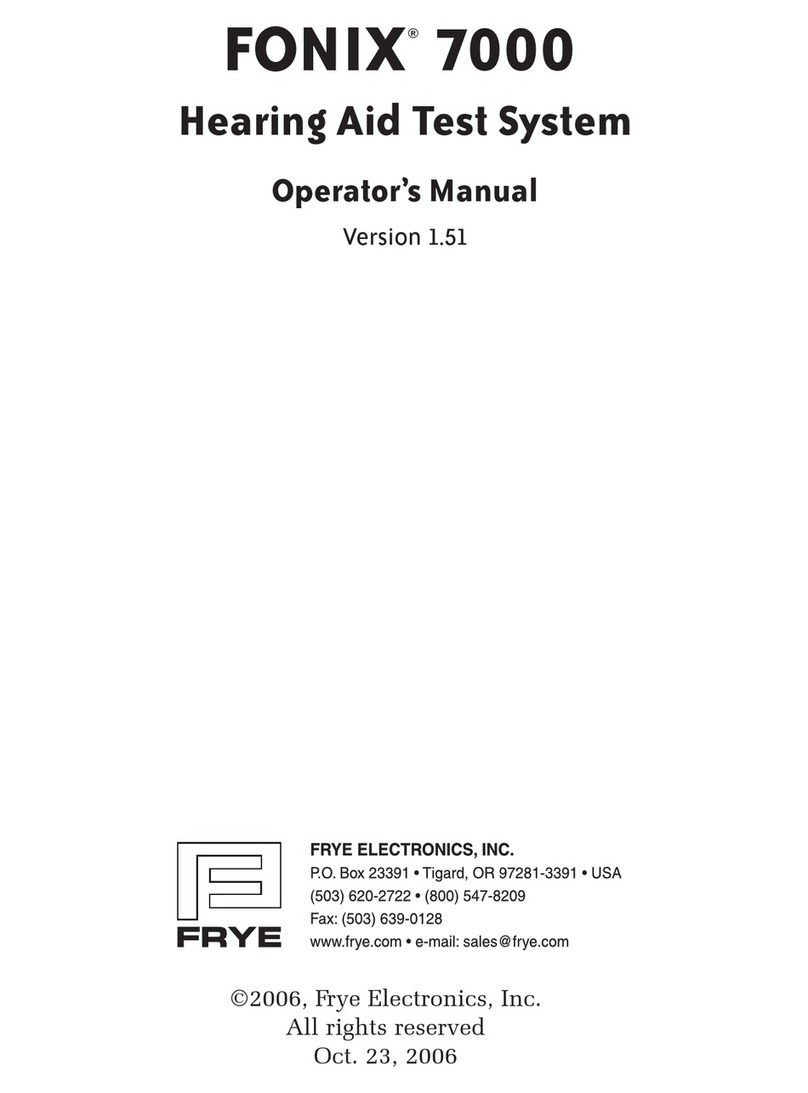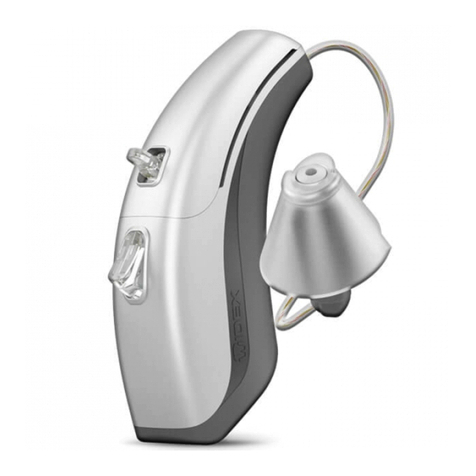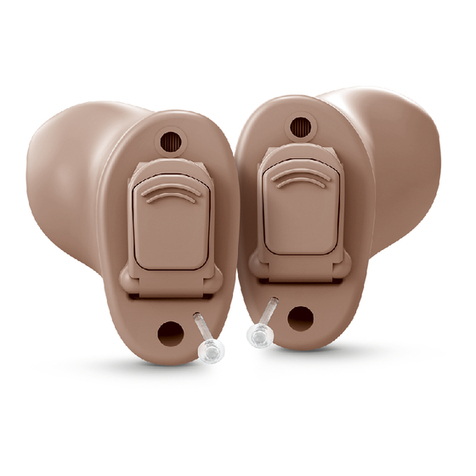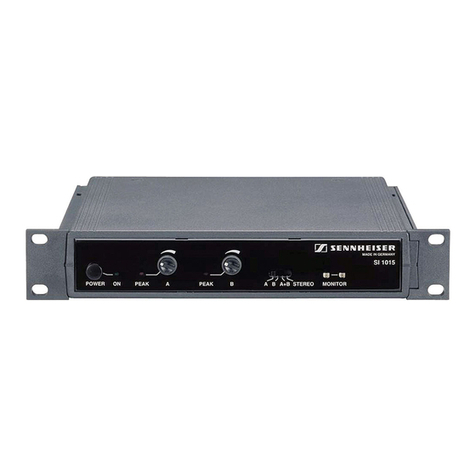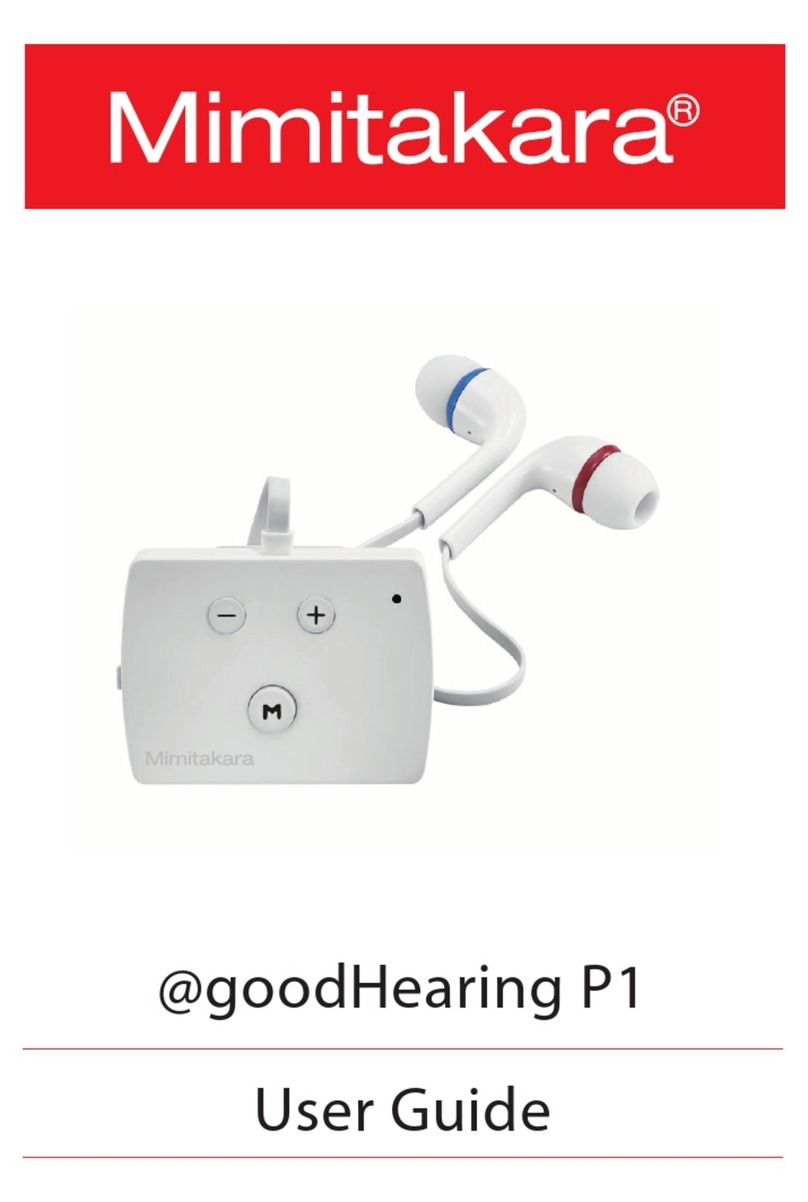NEURELEC SAPHYR SP User manual

1
www.neurelec.com
USER’S MANUAL
Behind the ear headset processors
РУКОВОДСТВО ПОЛЬЗОВАТЕЛЯ
Заушные речевые процессоры
PODRĘCZNIK UŻYTKOWNIKA
Zauszne procesory mowy
MANUALUL UTILIZATORULUI
Procesor retroauricular
POUŽÍVATEĽSKÁ PRÍRUČKA
Záušné procesory s náhlavnou súpravou
®
®®
MU SAPHIR.ZONE 3.indd 1 18/05/2010 18:06:29

2
EN - Instructions in English are found on pages 1 to 20
RU - Инструкции на русском приведены на стр. 23 - 42
PL - Instrukcja w języku polskim jest dostępna na stronach od 45 do 64
RO - Instrucţiunile în limba romană se găsesc la paginile 67 până 86
SK - pokyny v slovenčine nájdete na str. 89 až 108.
MU SAPHIR.ZONE 3.indd 2 18/05/2010 18:06:29

1
CONTENTS
INTRODUCTION .................................................... 2
HOW IT WORKS ..................................................... 4
CONTENTS OFTHE SAPHYR CASE ................. 5
DESCRIPTION OF THE SAPHYR ...................... 6
USING THE SAPHYR ............................................ 8
1 - CONNECTING THE COMPONENTS .................. 8
2- OPTIMIZATION OF POSITIONING ................... 8
- Magnet .............................................................. 8
- Hook .................................................................. 8
- Holding Buckle ............................................... 9
3 -POWERING THE PROCESSOR ........................... 9
- Type of batteries ............................................ 9
- Batteries lifespan ........................................... 9
- User advice ...................................................... 9
- Changing the batteries ................................ 9
4 START/STOP ......................................................... 10
5 -PROGRAM SELECTOR ........................................ 10
6 -ADJUSTMENT WHEEL ........................................ 11
7 -
LIGHT INDICATOR
................................................ 11
ASSISTIVE LISTENING DEVICES .................... 11
1 - INTEGRATED TELECOIL .....................................
. 11
2 -OTHER DIRECT CONNECTION AIDS ................ 12
MAINTENANCE AND USER ADVICE ............. 12
1 - MAINTENANCE .......................................................... 12
- Precautions ........................................................... 12
- Cleaning ................................................................... 13
- Storage ..................................................................... 13
- Drying system ..................................................... 13
- Recycling .................................................................. 13
2 -USER ADVICE ......................................................... 13
- Electrostatic discharges ............................... 13
- Passing through security gates ................ 14
- Travelling by air ................................................... 14
- Playing sports ...................................................... 14
TROUBLESHOOTING - TOOLS -
PROBLEMSAND SOLUTIONS ........................ 14
1 - TEST TOOLS ............................................................ 14
- Using the tester .............................................. 14
- Earphones ......................................................... 15
2 - PROBLEMS AND SOLUTIONS ........................... 15
- No sound perceived ...................................... 15
- Intermittent sound ......................................... 15
- Reduced or distorted sound ..................... 15
- Battery power supply insucient ......... 16
- Problem with antenna .............................. 16
MISCELLANEOUS ................................................... 17
1 - TECHNICAL CHARACTERISTICS ...................... 17
2 - SYMBOLS .................................................................... 17
3 - OPERATOR PROFILE ............................................... 17
4 - MANUFACTURER’S DECLARATION ............... 18
MU SAPHIR.ZONE 3.indd 1 18/05/2010 18:06:29

2
INTRODUCTION
YouhavejustreceivedaSaphyrprocessor,designed,developedandmanufacturedbyNeurelec.
This high technology hearing prosthesis with an implanted receiver is designed for rehabilitation of
children’s and adults’profound to total deafness. If the anatomical shape of the ear does not allow the
use of the Saphyr processor (because of a too tiny or supple pinna that cannot hold the prosthesis,
for instance), a micro-contour processor will be suggested. The Saphyr processor is available in two
versions (Saphyr SP and Saphyr CX) depending on compatibility with the generation of implanted
receiver as detailed below. It cannot be indicated for recipients who received another implant system.
Cochlear implant
Binaural cochlear implant
Brainstem implant
Saphyr SP
iscompatiblewiththeimplants:
Saphyr CX
iscompatiblewiththeimplants:
Cochlear implants
Brainstem implant
Digisonic DX10 and
Digisonic Convex
MU SAPHIR.ZONE 3.indd 2 18/05/2010 18:06:29

3
This manual that comes with the Saphyr processor tells you about the use of the device and
about the precautions that should be taken in use.
The model of the processor (Saphyr SP and/or Saphyr CX) will be specied only when information
is specic to one or the other of the models. We urge you to read this document carefully before
using the device.
NB:it is important that you always keep with you your cochlear implant owner card lled in by
your implantation centre and to present it every time you undergo a medical examination or
medicaltreatment.
Your implanted receptor contains a permanent magnet and is sensitive to electric currents.
Consult your implantation centre or Neurelec immediately before any electrotherapy or any
exposure to intense radiation (such as radiation therapy). Otherwise, please always remove
the external part before undergoing any medical examination (such as radiation therapy, MRI,
echography, scanning, etc).
Your implant system is compatible with 1.5 Tesla MRI imaging. Your processor should always be
removed if you are close to a place with a strong magnetic eld. The MRI request form (available
at www.neurelec.com) should be immediately lled in by the radiology department involved and
returned to Neurelec before any examination is carried out.
The acquisition of a Saphyr processor requires a number of adjustments to achieve optimum
hearing quality. If there are any abnormal sensations or pain during use of your equipment, remove
the antenna and contact your implantation centre. For young children, parents and teachers are
advised to monitor the child’s behaviour when using the processor. An adjustment check by your
audiologist is necessary at least once a year for good functioning of your cochlear implant system.
Each processor is programmed using the adjustment software for your personal use by an
audiologist trained by Neurelec, and should in no case be lent to or exchanged with another
person. The use of the processor by another person could provoke very loud or distorted sound
sensations. Always consult your adjustment centre.
The Saphyr processor contains high performance electrical components. Avoid any exposure to
extreme temperatures, avoid dropping it or immersing it partially or totally in water. The equipment
does not contain any component which can be repaired by the user or the implantation centre;
ifyou try to open the processor, this will automatically void the warranty. If there is any problem,
yourprocessor must always be returned to Neurelec after-sales service. In fact, any work carried
out on the Saphyr by someone not trained by Neurelec risks damaging the equipment and making
itdangerous to use.
We strongly advise you to take out insurance against loss, theft or irreparable damage. Enquire
about this at your implantation centre.
Throughout this document, only the cochlear implant system will be mentioned even if the Saphyr
processor is just as compatible with the various implants mentioned previously. The cochlear
implant system is an active implantable medical device. To ensure your safety, the Saphyr processor
is designed and manufactured in compliance with the requirements of the European directive
90/385/CEE. The device complies with the standard on the general rules on safety of electromedical
equipment NF EN 60601-1: 2006, as well as to the collateral standards NF EN 60601-1-1: 2001
(safety rules for electromedical systems), NF EN 60601-1-2: 2007 (electromagnetic compatibility),
NF EN 62304: 2006 (software life cycle process) and NF EN 60601-1-6: 2007 (usability).
MU SAPHIR.ZONE 3.indd 3 18/05/2010 18:06:29

4
Only use accessories supplied by Neurelec with this equipment or accessories specied as
compatible by Neurelec. The use of non-compatible accessories can generate uncontrolled
electromagnetic disruptions.
The processor you have just received is composed of a number of small components (leads,
magnets, batteries, etc.). Neurelec wants to remind families of young children that these small
components can be swallowed or inhaled. If they are swallowed or inhaled, please consult a doctor
straight away.
HOW IT WORKS
The cochlear implant system comprises an external part and an internal part.
The external part
• A miniaturized signal processor in a Saphyr behind the ear contour (1) containing two
microphones.
• An external antenna (2) connected to the processor by an antenna lead (3).
The sound captured by the microphones is treated digitally by the processor.
The stimulation signal is then sent to the implant by the antenna through the skin.
The internal part
The implant is a small ceramic case (4) placed under the skin. It contains an electronic stimulator
which distributes the sound to the 20 electrodes (5) placed in the cochlea.
Digital signal
Antenna lead
Saphyr processor
Antenna
Implant
Electrodes
To the brain
MU SAPHIR.ZONE 3.indd 4 18/05/2010 18:06:29

5
CONTENTS OF THE SAPHYR CASE
The Saphyr processor is supplied in a case which contains:
• 1 Saphyr processor (1)
•1 Antenna with a force 5 magnet (2)
•1 Antenna lead (3)
•1 Case (4)
•"Perfect dry" heated dryer box (5)
•1 Batch of Zinc Air batteries (6)
•1 Box of accessories containing:
- 1 Spare antenna lead
- 1 Spare force 4 magnet (7)
- 1 Additional hook (to be screwed in) (8)
- 1 Holding buckle (9)
- 1 Clip-on cover (10)
- 1 Mobile kit (11)
- 1 Audio cable (12)
- 1 Set of earphones (13)
• 1 Transport case (14) containing:
- 1 Tester (15)
- 1 Blister pack of 6 batteries
- 2 Cleaning wipes (16)
- 1 Drying Bag
- 1 Card holder (17)
- 1 Backup USB key (18)
•Documents:
- 1 User’s Manual (19)
- 1
User’s Manual for Accessories
(20)
- 1 Record of ttings (21) and speech
therapy follow-up
- 1
Warranty registration card
(22)
- Other items (certicate of processor
warranty, etc.)
1
3
2
7
15
9 8
6
20 2119 22
1718
16
54
14
10 13 12
11
MU SAPHIR.ZONE 3.indd 5 18/05/2010 18:06:29

6
DESCRIPTION OF THE SAPHYR
• Microphone 1 (A)
• Microphone 2 (B)
• Adjustment wheel with switch (C)
0 : Stop – 1: Position 1 - 2 : Position 2 - 3 : Position 3
• 4 position program selector (D):
P1 : Program 1 - P2 : Program 2 - P3 : Program 3 - P4 : Program 4
• Two colored light indicator (E)
• "ANT" socket (F): Connection of antenna lead
• "AUX" socket (G): Connection of external accessories (FM system, earphones, etc)
• Connection socket for adjustments (H)
The Saphyr SP and Saphyr CX processors dier in the appearance of their marking, their serial
number identication and some of their accessories (antenna, magnet and antenna lead).
The following illustrations describe the dierences in each product.
The serial number of your Saphyr SP processor is marked on the inside of the battery compartment:
For example: "J1495" (J = generation of the processor / XXXX = manufacturing number).
We advise you to make a note of this number and keep it safe in case you are asked for it.
Saphyr SP processor
Antenna lead with locating pin
Antenna with locating pin
Saphyr SP
MU SAPHIR.ZONE 3.indd 6 18/05/2010 18:06:30

7
Saphyr CX processor
Antenna lead without locating pin
Antenna without locating pin
Saphyr CX
The serial number of your Saphyr CX processor is indicated on the inside of the battery compartment:
For example: "K1245": (K = generation of the processor / XXXX = manufacturing number)
We advise you to make a note of this number and keep it safe in case you are asked for it.
MU SAPHIR.ZONE 3.indd 7 18/05/2010 18:06:30

8
USING THE SAPHYR
1 - CONNECTING THE COMPONENTS
The two ends of the antenna lead are identical to avoid any confusion for the user. They should be
used as recommended in the following manner:
• Connect the antenna to the antenna lead
• Connect the antenna lead to the processor at the socket marked "ANT".
The ends of the antenna lead and the antenna of the Saphyr SP processor have a locating pin.
It is therefore necessary to make sure that the locating pin at the socket and the lead are the
right wayround when connecting the antenna lead to the processor and the antenna lead to
theantenna (see the paragraph "Description of the Saphyr").
Important: the antenna lead connectors have been designed to be meticulously looked after
(changing of defective lead, etc.). For a longer life for this accessory, we advise that you store your
Saphyr processor in its case without disconnecting the antenna lead.
2 - OPTIMIZATION OF THE POSITIONING
Magnet
The antenna is held in place on the skin in relation to the implant by a magnet.
You can change the distance between the skin and the magnet at any time by turning the magnet
top: turn to the left to unscrew and to the right to screw back.
The lower face of the magnet provides information about the power of magnetisation (force 5 as
standard) and its compatibility with the processor model, as represented below:
Saphyr SP – lower face
5
+
Saphyr CX – lower face
5
-
If the magnetic power is insucient, it can generate poor support of the antenna on the skin.
If it is too powerful, skin irritation or redness can appear. In these cases, we recommend changing
the magnet by replacing it with a lower power magnet (force 4 magnet supplied in the case)
ifskin redness persists. Do not hesitate to consult your implantation centre if the magnet does not
seem suitable to you. They will advise you on the power to use and how to order from your local
distributor or Neurelec after sales service.
Hook
The processor is supplied with a hook for holding it on the ear. So that it can be adapted to each
patient, a dierent type of hook supplied in the case can also be adapted to the Saphyr processor.
Changing the hook is performed in the following manner:
• Remove the hook used by unscrewing it
• Screw in the new hook. The rst use requires making the thread.
MU SAPHIR.ZONE 3.indd 8 18/05/2010 18:06:30

9
Holding buckle
For optimum support of the processor on the ear (especially when used for children),
werecommend you use the silicon holding buckle supplied in the Saphyr case. We advise referring
to the instructions for use supplied with this accessory for understanding how to put it in place,
orto the "User’s Manual for Accessories".
NB: the processor support can also be protected by using an open ear mold nozzle made to order
by an audioprosthetist.
3 - POWERING THE PROCESSOR
Type of batteries
Your Saphyr processor functions with 2 Zinc Air 675 non-rechargeable batteries. It is important
that you use only Zinc Air "675" (European designation) type batteries or "PR44" (international
designation) recommended by your implantation centre or Neurelec. If you use another type
of battery, you risk compromising the proper functioning of the Saphyr (reduced battery life,
faultypower supply to your processor).
To renew your supply of batteries you can contact your local distributor or Neurelec after sales
service directly.
You will nd references to the dierent types of battery recommended (for cold and dry or hot
andhumid weather) at good prices on the Saphyr accessories order form.
Batteries lifespan
Battery life varies from one patient to another, depending on settings, the sound environment
and the daily use of the equipment. It ranges on average from 2 to 8 days. It is important to
follow the user advice. If the batteries do not last as long as this, we advise you to contact your
implantationcentre, your local distributor or the Neurelec after sales service.
User advice
We recommend storing batteries in a dry place protected from temperature variations, and to
keep to the use-by date on the packaging. The two batteries used to power the Saphyr should be
of the same type and should be changed at the same time. It is important to take the batteries out
when your processor is not switched on for long periods (at night for example).
Important: The Saphyr processor comprises small components which may represent a danger if
they are swallowed. Please keep the batteries out of the reach of children1.
Zinc Air batteries are non-rechargeable and disposable and should not be thrown away but taken
to a collection centre (sales point, waste reception centre, etc) or placed in containers designed for
this purpose. Please refer to the legislation in force.
Changing the batteries
The Saphyr processor tells you when the batteries need replacing when you hear three consecutive
beeps (private alarm) not perceptible to those around you. Both the batteries should be changed
when you hear these three warning sounds, or when sound stops or sound perception deteriorates.
It is imperative that used batteries are changed quickly, as they could spread corrosive liquid likely
to damage your processor. Battery replacement is carried out as follows:
1- Remove the protective lm from the new batteries
2- Turn o processor (turn wheel to "0")
3- Remove the used batteries and place two new batteries in the compartment, making sure that
they are the right way round according to the markings on the compartment (the batteries will t
only one way round).
It is important to clean the battery compartment regularly to avoid any build-up of matter.
MU SAPHIR.ZONE 3.indd 9 18/05/2010 18:06:30

10
You can then switch your processor back on (turn the wheel up to the appropriate position).
4 - START/STOP
To switch the equipment on, position the selector on the program dened by your implantation
centre (P1, P2, P3 or P4), then turn the wheel up in order to switch on the processor.
Adjust the position of the wheel to optimize your hearing comfort depending on the sound
environment (according to the conguration dened with the audiologist).
To stop the equipment, turn the wheel down to "0" until there is a click perceptible by touch.
If the equipment is out of action for a long period (such as during the night), we recommend
following the following procedure:
• Switch o the equipment
• Open the battery compartment and take out the two batteries
• Place your Saphyr in the drying box, taking to follow the instructions on the accompanying sheet
or in the "User’s Manual for Accessories". Then close it until the next use of the processor.
This operation allows humidity accumulated during use of the equipment to be absorbed, dries
out the battery contacts and prevents possible failure of the processor.
NB: This processor has an automatic restart device if it malfunctions. This causes a momentary
power break.
5 - PROGRAM SELECTOR
The Saphyr processor oers the possibility of storing up to four dierent programs (P1, P2, P3, P4).
The audiologist in charge of adjustments can dene these programs depending on conditions of
use (normal sound environment, noisy environment, use of FM system, Telecoil, etc.).
All you have to do is change the selector position to dene the program required according to your
hearing needs. This function can be locked on request during an adjustment session, depending
on your preferences or needs, to make it easier to use your equipment.
In addition, the processor can indicate to its user any program change by emitting sound beeps
not perceptible by people around you if this function has been activated by the audiologist.
Accordingly, one beep will come when the selector switches on position P1, two beeps on
positionP2, etc.
MU SAPHIR.ZONE 3.indd 10 18/05/2010 18:06:30

11
6 - ADJUSTMENT WHEEL
This programmable function allows you to adapt your hearing according to the sound
environment, depending on the mode congured, . Your audiologist will dene with you the most
appropriate mode for your daily life and will show you the correct adjustment for using each of
the programs.
Changing the position of the wheel to nd the most comfortable hearing position. This function
can also be locked during an adjustment session, especially for young children, to avoid incorrect
handling or to make it easier to use your equipment.
7 - LIGHT INDICATOR
The two-colored (green/red) warning light on the Saphyr enables you to easily identify the state
of the processor, particularly for people unused to handling the equipment (teachers, youth
workers, etc):
Start up test
When you start it up, the warning light lights up systematically and briey
in green; it then goes out.
Indication of stimulation
The light indicator The light ashes green depending on the sound
captured by the microphone. This light conguration can be deactivated
at your request by the audiologist in charge of adjustments.
Detecting battery discharge
The indicator ashes red at a slow rate (every 2 seconds) and for 1 minute.
This is the time to switch o the processor and change the batteries. This
indicator conguration can be deactivated if you ask your audiologist.
Detection of any other errors
The indicator ashes red rapidly for 1 minute, then automatically restarts, causing it to cut out
momentarily. If the problem persists, contact your local distributor or Neurelec after sales service.
The person in charge of adjustments will select with you the conguration most suited to the daily
use of your equipment.
ASSISTIVE LISTENING DEVICES
Assistive Listening Devices improve understanding of speech in noisy environments by reducing
the eect of distance between the sound source and the user.
1 - INTEGRATED TELECOIL
The magnetic induction loop (or telecoil) is a hearing aid device based on the principle of
transmitting sound by magnetic induction between a transmitter and a receiver connected
to the user. The Saphyr processor has an integrated induction loop receiver compatible with
the transmitters installed in public places (theatres, conference room, places of worship, etc),
ampliers for domestic installation (television, hi-) and telephones with integrated induction
loop transmitters. This induction loop is activated simply by turning the Saphyr selector to the
program dened with your implantation centre (P1, P2, P3 or P4).
MU SAPHIR.ZONE 3.indd 11 18/05/2010 18:06:30

12
2 - OTHER DIRECT CONNECTION AIDS
The Saphyr processor has an integrated direct connection compatible with various auxiliary
hearing systems such as those below, available in the shops or suggested by your local distributor
and Neurelec.
Compatibility
FM system
Audio cable Mobile kit
Use of such systems requires prior adjustment at your implantation centre to dene a specic
new program: It is necessary to dene the audio mix between sound captured by your processor
microphone and that of the auxiliary system. Then all you have to do is to connect your system to
the “AUX” socket of the Saphyr, switch on the equipment used (telephone, MP3 player, etc) and
select the program dened by your audiologist (P1, P2, P3 or P4). It is possible to dene a program
by type of auxiliary system.
For more information on the conditions and recommendations for use relating to these auxiliary
hearing aid systems, please refer to the "User’s Manual for Accessories" supplied in this case.
MAINTENANCE AND USER ADVICE
1 - MAINTENANCE
Precautions
The Saphyr processor contains high performance electrical components that can be damaged.
Itshould therefore be used with caution. If you drop it, check that the device continues to function
normally. If you are not sure, do not hesitate to repair it. Contact the Neurelec after service, which
is the only location competent to guarantee maintenance of its products.
It is important not to immerse your processor in water in order to avoid damaging the electronic
components. Accordingly, do not wear the device in the shower, in the bath, or while swimming.
If it drops into salty water, turn o the processor, remove the batteries, and immediately rinse the
material in clear water. Let it dry for 24 hours.
Be careful always to disconnect the antenna lead without abrupt movements while holding the
socket with two ngers. You risk damaging the lead if you pull it straight down. We strongly
advise that you own one or several reserve lead s. We recommend an annual checkup of your
device, which will allow verifying that is functioning properly and will verify the calibration of the
microphones, thus optimizing their lifetime.
MU SAPHIR.ZONE 3.indd 12 18/05/2010 18:06:31

13
Cleaning
Clean the processor regularly and very carefully with a cotton bud or preferably a sti brush
slightly dampened with alcohol. Keep the microphones clear of dust, dirt, sweat and damp.
Cleaning wipes are also supplied in the case. These wipes are impregnated with an antibacterial
and antifungal solution which eectively dissolve ear wax and remove dust and sweat residues.
For more information please refer to the "User’s Manual for Accessories".
Storage
We recommend placing the entire external apparatus away from direct sunshine and heat.
The processor should particularly be protected from dust, moisture, mechanical vibrations
and shocks.
On a daily basis, your case is designed to store the processor every time you are not using it.
All you need to do is to remove the batteries before placing the equipment in the impression
provided. For more information please refer to the "User’s Manual for Accessories".
Drying system
If your processor is not being used for any length of time (particularly during the night),
werecommend that you remove the 2 batteries and place the Saphyr in the drying box supplied
to absorb any residual moisture. Please read the instructions for use for the drying system before
using it, or refer to the "User’s Manual for Accessories".
The batteries should be stored in a cool (<20°C), dry place, protected from direct sunlight and heat.
Recycling
The directive 2002/96/CEE (DEEE) has for its priority objective the prevention of electrical and
electronic waste and its re-use, by recycling this and other forms of use of this waste in a way to
reduce the quantity of waste to be removed. The "dustbin" icon indicates that equipment should
not be thrown out with household waste but should be collected separately. The equipment
should be taken to a suitable collection point for processing. This helps to save natural resources
and protect human health.
2 - USER ADVICE
Electrostatic discharge
Electrostatic discharges correspond to visible sparks when two people brush against one another
or against an object in cold and dry climates. The contact of certain elements may favor the
appearanceof suchdischarges (clothesof syntheticmaterial, gettingout ofa car,aplastictoboggan,
computer or television screens, wall-to-wall carpets, etc.). The Saphyr processor is designed to
give robust protection in the face of this phenomenon of electrostatic discharges (inconformity
with standard NF EN 606601-1-2: 2007) to avoid damaging the device or changing the hearing
program. Wenonetheless advise you to take certain precautions to avoid such discharges: take
o a sweater gently, get out of a vehicle cautiously, etc. In addition, any one liable to be in contact
with the processor should be careful to touch the person with a cochlear implant system before
touching the device in order to eliminate any residual static electricity.
MU SAPHIR.ZONE 3.indd 13 18/05/2010 18:06:31

14
Passing through security gates
Security gates (airports, shopping centers, etc) produce powerful electromagnetic elds. Passing
through or near these gates can set o the detector alarm or disrupt the sound perceived by the
implant wearer. We therefore advise that you turn o your processor and warn security guards by
showing your owner card.
Travelling by air
As with all electronic equipment, it is imperative to turn o your processor during take-o and
landing of the aircraft.
Playing sports
The cochlear implant system allows you to take part in the majority of sporting activities.
However,some precautions should be taken, and it may be necessary, depending on the sport,
to wear a protective helmet and a processor support system or to remove the processor. A violent
shock could damage your cochlear implant system. We therefore advise against participating in
contact sports. Diving below a depth of 5 m is also inadvisable.
The clip-on cover supplied in the case is designed specically for the Saphyr processor. It protects
your processor from moisture and perspiration and provides additional security when taking
part in certain open air sporting activities. For more information, refer to the "User’s Manual
forAccessories".
TROUBLESHOOTING - TOOLS - PROBLEMS
ANDSOLUTIONS
1 - TEST TOOLS
Various functions and tools are available so that you can check that your Saphyr processor and
itsaccessories are functioning well:
• Light indicator (see page 11)
• Private alarm for detecting end of battery life (see page 9)
• Tester
• Earphones.
It is important to understand how these tools function for daily management of your equipment.
Using the tester
The tester enables you to check that your Saphyr processor
and its accessories are working well and to check that
theantenna is sending a good signal to the implant through
the skin.
The test is done as follows:
• Place the processor antenna on the tester (from the indicator
light side). It is held on magnetically.
• The processor should be running on the program
currentlyused.
• The tester light should light up with every sound stimulation.
If that is not the case, the signal has not been perceived by
the implant (no sound perceived). Refer to the chapter:
"Problems and solutions".
MU SAPHIR.ZONE 3.indd 14 18/05/2010 18:06:31

15
NB: The tester supplied with the Saphyr SP processor has a translucent yellow light while the
tester supplied with the Saphyr CX includes a green light.
Earphones
The Saphyr processor is tted with an earphone socket so that a person without defective hearing
can hear the audio signals entering the processor. This is useful for diagnosing problems with the
microphone (microphone inlet obstructed, faulty microphone).
This test tool is used as follows:
• Turn o the processor
• Gently plug in the earphones to the auxiliary socket marked "AUX" on your processor, making
sure it is connected the right way round
• Switch on the processor to your usual program to check the sound quality perceived
• After use, turn o the processor again before disconnecting the earphones.
NB: There is a risk of the Larsen eect if the earphones are too close to the microphone. The sound
level perceived by a third hearing person using the earphones is not representative of that sensed
by the patient.
2 - PROBLEMS AND SOLUTIONS
The combined use of dierent test tools and the application of the advice below will enable you
to solve any problems encountered. If the problem persists, we recommend that you contact your
implantation centre, your local distributor or the Neurelec after sales service.
No sound perceived
1 - Check the condition of the processor (correct connection of the antenna lead, battery
compartment closed, position of the wheel and selector)
2 - Change the two batteries
3 - Check the microphone quality using the earphones
4 - Check that the antenna lead and the antenna are functioning properly by using the tester
5 - Change the antenna lead or the antenna
6 - Contact your implantation centre, your local distributor or the Neurelec after sales service.
Intermittent sound
1 - Check that the position of the wheel and the program choice have been adjusted
to the soundconditions
2 - Change the two batteries
3 - Check that the maintenance advice has been respected (see page 12)
4 - Check the condition of the antenna lead and the antenna by using the tester
5 - Contact your implantation centre, your local distributor or the Neurelec after sales service.
Reduced or distorted sound
1 - Check that the position of the wheel and the program choice have been adjusted
to the soundconditions
2 - Try another program
3 - Change the batteries
4 - Check the microphone quality using the earphones
5 - Contact your implantation centre, your local distributor or the Neurelec after sales service.
MU SAPHIR.ZONE 3.indd 15 18/05/2010 18:06:31

16
Battery power supply insucient (<2 days)
1 - Change the two batteries
2 - Check the type of battery used
3 - Check that the maintenance advice has been respected (see page 12)
4 - Contact your implantation centre, your local distributor or the Neurelec after sales service.
Problem with antenna
If support is insucient:
1 - Tighten the magnet by screwing it in
2 - Ask the advice of your implantation centre to obtain a stronger magnet.
If support is too tight:
1 - Unscrew the magnet to loosen it
2 - Ask the advice of your implantation centre to change the magnet.
(Aforce4magnetissupplied in the Saphyr case).
Important: if you send anything to your local distributor or Neurelec after sales service,
itshould be accompanied by a detailed description of the problems.
MU SAPHIR.ZONE 3.indd 16 18/05/2010 18:06:31

17
MISCELLANEOUS
1 - TECHNICAL CHARACTERISTICS
Processor Dimensions max: 53 x 30 x 11 mm
Weight (with batteries): 11,4 g
Power
Range of functioning of the device: from 1.8 V to 3.7 V
2 x 675 Zinc Air disposable batteries
Maximum consumption: 60 mW
Maximum transmission power: 35 mW
Storage and transport
conditions
Storage and transport temperature: -20° C to 50° C
Relative humidity: 0 to 90%
Atmospheric pressure: 700 hPa to 1060 hPa
Conditions for use
Temperature for use: 5° C to 40° C
Relative humidity: 0 to 90%
Atmospheric pressure: 700 hPa to 1060 hPa
2 - SYMBOLS
Please consult the accompanying documents
Waste electric andelectronic equipment (WEEE)
Type B equipment
Switching the processor on/o
P675: Format “675” Zinc Air batteries (European designation)
or“PR44” (international designation)
+: Direction for positioning the battery
Instructions for use
3 - OPERATOR PROFILE
The patient is the operator when he:
• changes the batteries
• turns on and turns o the processor
• changes the program
• connects and disconnects the antenna lead.
Children under age 7 should
do these things under an
adult’s supervision.
MU SAPHIR.ZONE 3.indd 17 18/05/2010 18:06:32

18
4 - MANUFACTURER'S DECLARATION
Electromedical equipment requires special precautions regarding EMC (electromagnetic
compatibility), and it is necessary to install such equipment and set it up in accordance with the
EMC information supplied in the tables below. Portable RF (radiofrequency) communication
equipment such as mobile phones can aect the functioning of the Saphyr. This equipment
shouldbe kept asfar away from the Saphyr and its accessories as possible to eliminate these eects.
Directives and manufacturer’s declaration – Electromagnetic emissions
The Saphyr is designed to be used in the electromagnetic environment specied below.
The Saphyr user should make sure that it is used in such an environment.
Emissions test Conformity Electromagnetic environment – Directives
RF emissions CISPR 11 Group 1 The Saphyruses RF energy only for its internal functions. As a result,
its RF emissions are very weak and not likely to cause interference
in a neighbouring piece of electronic equipment.
RF emissions CISPR 11 Class B The Saphyris suitable for use in any establishments including
domestic premises and those directly linked with public network
low voltage electrical energy supplying buildings for domestic use.
Harmonic emissions
CEI 61000-3-2
Not applicable
Fluctuating/ickering
voltageemissions
CEI 61000-3-3
Not applicable
Directives and manufacturer’s declaration – Electromagnetic immunity
The Saphyr is designed to be used in the electromagnetic environment specied below.
The Saphyr user should make sure that it is used in such an environment.
Immunity test Test level
CEI 60601
Level of
conformity Electromagnetic environment – Directives
Electrostatic
discharge(DES)
CEI 61000-4-2
±6 kV on contact
±15 kV in the air
±2, ±4, ±6 kV
oncontact
±2, ±4, ±6 ±8
kV in the air
Floors should be made of wood, concrete or
ceramic tiles. If oors are covered in synthetic
material relative humidity should be at least 30%.
Bursts of fast transients
CEI 61000-4-4
±2 kV for electrical
power lines
±1 kV for input/
output lines
Not applicable Not applicable
Shock waves
CEI 61000-4-5
±1 kV dierential
mode
±2 kV common
mode
Not applicable Not applicable
Drops ion power,
short power cuts and
variations in power on
electrical supply lines
CEI 61000-4-11
<5% UT
(drop >95% de UT)
for 0.5 cycle
40% UT
(drop =60% of UT)
for 5 cycles
70% UT
(drop =30% of UT)
for 25 cycles
<5% UT
(drop >95% of UT)
for 5 seconds
Not applicable Not applicable
Magnetic eld at
the frequency of the
electricity network
(50/60 Hertz)
CEI 61000-4-8
100 A/m
(50/60 hertz)
100 A/m
(50/60 hertz)
Magnetic elds at the frequency of the electricity
network should have levels characteristic of
arepresentative place in a typical commercial or
hospital environment.
MU SAPHIR.ZONE 3.indd 18 18/05/2010 18:06:32
This manual suits for next models
1
Table of contents
Languages:
